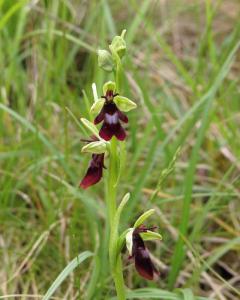Ashton Court, a walled estate just to the west of Bristol is famous for hosting the Bristol International Balloon Fiesta, but it has a botanical claim to fame too: the only accessible Green-flowered Helleborines (Epipactis phyllanthes) in the Bristol area grow here, in a dark wooded part of the estate called Clarken Combe, just a short hop over the wall from a layby on the B3128. I paid the site a very quick visit last weekend and was surprised to find many more plants than I’ve seen here previously, although all were still in bud. This weekend, however, several were flowering: mostly each plant had just a single stem, but one plant had a cluster of nine: here is a photo, and a close-up of some of the individual flowers.
 |
 |
These plants have an interesting history. Originally found in 1985, they were thought to be Narrow-lipped Helleborines (Epipactis leptochila), a scarce species of limestone beechwoods. They were listed as this species in the Flora of the Bristol Region, published in 2000, and this identification remained unchallenged until fairly recently. I paid the site a visit in late summer 2011, not really knowing any more than to look in the woodlands at Clarken Combe, I narrowed my search by looking under beech trees, and eventually found three helleborine plants, but they were past flowering, so I visited again in 2012 with Martyn Hall, who took some photos. Still none the wiser as to the plants’ true identity, I posted these to the orchid thread at Birdforum. Midlands-based orchid expert Sean Cole posted a reply, asking whether I was sure the plants were Narrow-lipped Helleborines, as they looked to him more like Green-flowered. That afternoon, Richard Mielcarek and I went back to Clarken Combe, gave the plants a very close look, and confirmed that, just as Sean thought, they were Green-flowered Helleborines.
Part of the reason for the confusion is that back in the 1980s, knowledge about the variability of the Epipactis helleborines, and which identification features are most reliable, was still developing: nevertheless, the plants had been visited by many knowledgeable botanists since, and so it’s surprising that it took so long for them to be re-identified.
Green-flowered Helleborine occurs in several varieties (forms of characteristic appearance caused by small genetic differences). The Clarken Combe flowers open quite widely, seem to have a clear distinction between the ‘cup’ (hypochile) and the ‘lip’ (epichile) and in some, the lip is bent back under the cup, whereas in others it is not, and then appears quite long and pointy. As I understand it, this points to them being of the variety known as ‘vectensis’, but I’d be interested in views from others with more knowledge of this subject. The pointy lower lip and the fact that the flowers open widely may be one of the reasons why the plants were originally thought to be Narrow-lipped Helleborines. However, the hypochile of Narrow-lipped Helleborine is filled with a sticky dark purplish liquid, not present in the Ashton Court plants, and the lip of Narrow-lipped is even longer and thinner. There are several other features visible with a hand-lens, which Richard and I checked last year to satisfy ourselves that our re-identification was correct.
In a local context, Green-flowered is only marginally less rare than Narrow-lipped. Narrow-lipped’s nearest population is in the woodlands at the top of Cheddar Gorge; Green-flowered occurred in the past on the towpath below Leigh Woods, but has not been seen here for many years, and only occurs at one other site, a private garden near Stowey. Further north, on the Cotswolds, both species have strong populations, and Green-flowered also occurs at several sites in Wiltshire. Nationally, Narrow-lipped is the scarcer of the two, and its populations are in decline, whereas Green-flowered is if anything on the increase.
Here is a map showing the location of the plants. If you visit, please take great care where you put your feet, as some of the plants are quite small. There are differing views among botanists about the levels of secrecy that should surround locations of scarce plants, and in particular orchids. One orchid site on the edge of Bristol suffered from theft of a very rare species this year, so concerns are very valid. Fortunately, I don’t have to make the decision over the Ashton Court plants, as Bristol City Council have publicised them for many years as one of the features of the site (albeit unwittingly as the wrong species).



